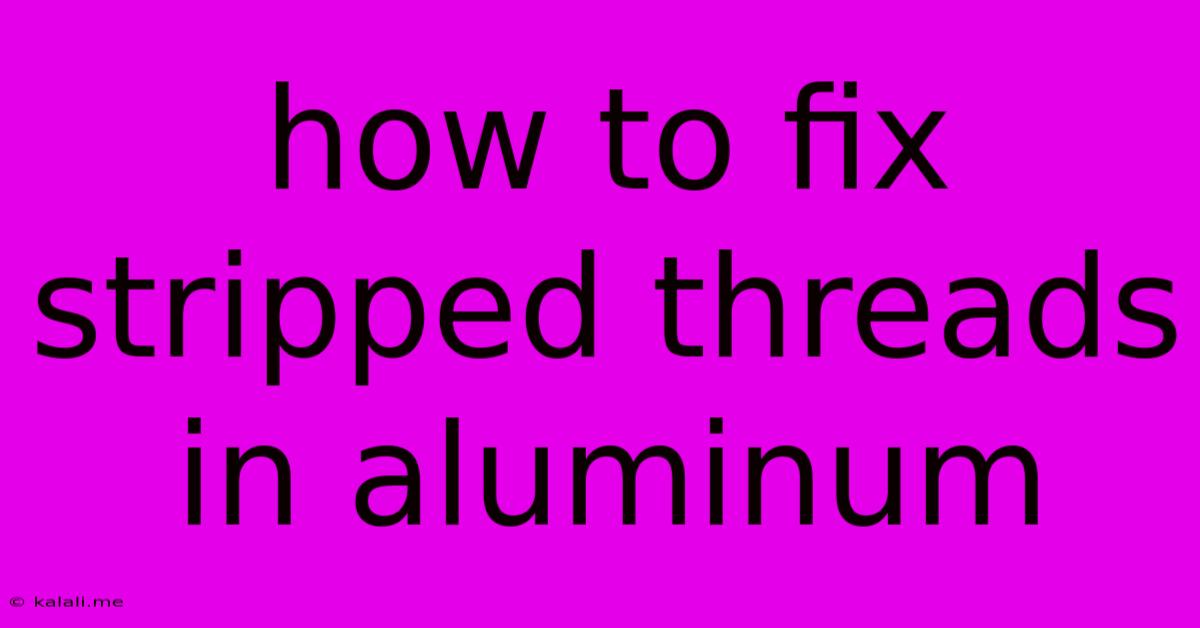How To Fix Stripped Threads In Aluminum
Kalali
May 29, 2025 · 4 min read

Table of Contents
How to Fix Stripped Threads in Aluminum: A Comprehensive Guide
Meta Description: Dealing with stripped threads in aluminum? This comprehensive guide explores various effective methods for repairing damaged threads, from simple fixes to more advanced techniques, ensuring a strong and lasting repair. Learn how to choose the right approach for your situation and get your project back on track.
Stripped threads in aluminum are a frustratingly common problem for DIYers and professionals alike. Whether you're working on a car engine, a piece of furniture, or a delicate electronic component, dealing with damaged threads can halt your project in its tracks. Fortunately, there are several effective ways to repair stripped aluminum threads, ranging from simple fixes to more involved solutions. This guide will walk you through the process, helping you choose the best method for your specific situation.
Assessing the Damage: The First Step
Before attempting any repair, carefully assess the extent of the damage. This will help determine the best repair strategy. Consider these factors:
- Severity of the stripping: Is it a minor imperfection or a significant amount of the thread damaged?
- Location of the damage: Is it easily accessible or in a difficult-to-reach area?
- Type of fastener: What size and type of screw or bolt is involved?
- Material thickness: How thick is the aluminum piece? Thin aluminum may be more prone to further damage during repair.
Repair Methods for Stripped Aluminum Threads
Several methods can effectively repair stripped aluminum threads. Here are some of the most common and reliable options:
1. Using a Thread Repair Kit (Helicoil or Time-Sert):
This is often the most reliable and durable solution, especially for heavily stripped threads or critical applications. Thread repair kits, such as Helicoil or Time-Sert, involve installing a new, hardened steel insert into the damaged threads. This provides a stronger, more resilient thread than the original aluminum. The process typically involves:
- Drilling out the damaged threads: This requires a precise drill bit to match the size of the repair insert.
- Tapping the new threads: A tap creates the new threads for the insert.
- Installing the insert: The insert is carefully installed into the tapped hole, providing a strong and reliable thread.
Pros: Durable, strong repair, suitable for high-stress applications. Cons: Requires specialized tools and some mechanical skill, more expensive than other methods.
2. Using a Larger Bolt or Screw:
If the stripping is minor, simply using a slightly larger bolt or screw with a new, appropriately sized hole might suffice. However, this weakens the surrounding material and should only be considered for low-stress applications. Ensure you have sufficient material surrounding the new hole to maintain strength.
Pros: Simple, quick fix. Cons: Weakens the surrounding material, not suitable for high-stress applications.
3. Applying Thread Locker:
For very minor stripping, a strong thread locker (like Loctite) can sometimes provide enough grip to secure the fastener. However, this is only a temporary solution and should not be used for applications requiring high strength or vibration resistance.
Pros: Quick, inexpensive solution for minor damage. Cons: Not durable, temporary solution only.
4. Aluminum Thread Repair Compound:
These specialized compounds fill in the stripped threads, allowing for a secure fit with the original fastener. They're easy to apply but may not be as durable as other methods for high-stress applications.
Pros: Easy to apply, relatively inexpensive. Cons: May not be as durable as other methods.
Choosing the Right Method
The best method for fixing stripped aluminum threads depends on the severity of the damage, the application, and your skill level. For critical applications or significant damage, a thread repair kit is the recommended solution. For minor damage in low-stress situations, using a slightly larger fastener or thread locker might suffice. Always prioritize safety and ensure the repair is strong enough for the intended application.
Preventing Stripped Threads in the Future
Preventing stripped threads is always easier than repairing them. Here are some tips to help avoid this problem in the future:
- Use the correct size drill bit: Using too large a drill bit weakens the threads.
- Lubricate the threads: Applying lubricant (like penetrating oil) to the threads before tightening reduces friction and prevents stripping.
- Tighten fasteners gradually: Avoid applying excessive force when tightening fasteners. Use a torque wrench where necessary to avoid over-tightening.
- Use the correct fasteners: Ensure you're using the correct type and size of screws or bolts for the application.
By following these tips and choosing the right repair method, you can successfully fix stripped aluminum threads and get your project back on track. Remember that safety should always be your top priority. If you're unsure about any of these methods, it’s always best to consult a professional.
Latest Posts
Latest Posts
-
Blender How To Make A Control Rig
May 30, 2025
-
What Should I Do With Extra Artifacts Stardew
May 30, 2025
-
No Buts No Cuts No Coconuts
May 30, 2025
-
At The Bottom Or In The Bottom
May 30, 2025
-
How Do You Know If An Outlet Is Grounded
May 30, 2025
Related Post
Thank you for visiting our website which covers about How To Fix Stripped Threads In Aluminum . We hope the information provided has been useful to you. Feel free to contact us if you have any questions or need further assistance. See you next time and don't miss to bookmark.